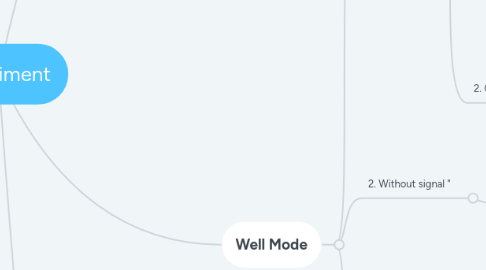
1. Mathematic model
1.1. 1. Electric currents
1.1.1. 1. frequency spectrum of Electric field distribution
1.1.1.1. 1. DC
1.1.1.1.1. 1. in DI water
1.1.1.1.2. 2. in PBS
1.1.1.2. 2. AC
1.1.1.2.1. 1. in DI water
1.1.1.2.2. 2. in PBS
1.1.2. 2. current density
1.2. 2. Nonisothermal flow
1.2.1. 1. only gravity
1.2.1.1. 1. the flow concentrate to the hole
1.2.2. 2. DC
1.2.2.1. 1. in DI water
1.2.2.1.1. 1. only Electro osmosis flow
1.2.2.1.2. 2. only Electro thermal flow
1.2.2.1.3. 3. Electro osmosis & Electro thermal
1.2.2.2. 2. in PBS
1.2.2.2.1. 1. only Electro osmosis flow
1.2.2.2.2. 2. only Electro thermal flow
1.2.2.2.3. 3. Electro osmosis & Electro thermal --"DC PBS Aug 13 whole"
1.2.3. 3. AC
1.2.3.1. 1. 10 Hz
1.2.3.1.1. 1. in DI water
1.2.3.1.2. 2. in PBS
1.2.3.2. 2. >100 Hz
1.2.3.2.1. 1. no EO flow, only ET flow and gravity
1.3. 3. Particle tracing
1.3.1. 1. Polystyrene beads
1.3.1.1. 1. DC
1.3.1.1.1. 1. In DI water
1.3.1.1.2. 2. In PBS
1.3.1.2. 2. AC
1.3.1.2.1. 1. in PBS
1.3.1.2.2. 2. in DI water
1.3.1.2.3. 3. in low conductivity bulk
1.3.2. 2. Live HeLa Cell
1.3.2.1. 1. DC in PBS
1.3.2.1.1. Attracted to the hole
1.3.2.2. 2. AC
1.3.2.2.1. 1. in PBS
1.3.3. 3. Dead HeLa Cell
1.3.3.1. AC
1.3.3.1.1. in PBS
1.3.3.2. DC
1.3.3.2.1. follow the EO
1.3.3.2.2. attract to the hole edge
2. Well Mode
2.1. 1. DC Signal
2.1.1. 1. Anode at top
2.1.1.1. 1. Polystyrene beads
2.1.1.1.1. 1. in DI water
2.1.1.1.2. 2. in PBS "Movie13 bounce back and stop"
2.1.1.2. 2. Hela cell
2.1.1.2.1. 1. in PBS "Cell PBS +25V"
2.1.1.2.2. 2. in electroporation bulk
2.1.2. 2. Cathode at top
2.1.2.1. 1. Polystyrene beads
2.1.2.1.1. 1. in DI water
2.1.2.1.2. 2. in PBS
2.1.2.2. 2. Hela cell
2.1.2.2.1. 1. in PBS "Cell PBS -25V"
2.1.2.2.2. 2. in electroporation bulk
2.2. 2. Without signal "
2.2.1. 1. The beads and cell can be attracted to the hole maybe because of gravity flow
2.3. 3. AC Signal
2.3.1. 1. 100mHz - 100 Hz
2.3.1.1. 1. Polystyrene beads
2.3.1.1.1. 1. in DI water
2.3.1.1.2. 2. in PBS
2.3.1.2. 2. Hela cell
2.3.1.2.1. 1. in PBS at 7Vpp 1 Hz- 100 Hz; "Cell pbs 100mHz "; 1Hz "Cell 30.9Vpp edge electroporated 2vpp 1 hz"
2.3.1.2.2. "Cell AC 10 Hz PBS" or "30.9Vpp bounce back and forth AC smaller than 10Hz"or"Cell AC smaller than 10 Hz edge stop"
2.3.2. 2. > 100 Hz (1kHz)
2.3.2.1. 1. Polystyrene beads
2.3.2.1.1. 1. in DI water
2.3.2.1.2. 2. in PBS "Jun4-20V 1kHz or 10k Hz"
2.3.2.2. 2. Hela cell
2.3.2.2.1. 1. in PBS
2.3.2.2.2. 2. in electroporation bulk
2.3.3. 3. 1 MHz
2.3.3.1. 1. the bead was repelled form the hole
3. Tip Mode
3.1. 1. DC signal
3.1.1. 1. Polystyrene beads
3.1.1.1. 1. Anode on top "14BT flying particles"
3.1.1.1.1. 1. 1.Most of the beads will lay on the ground of the glass because of the gravity force
3.1.1.1.2. 2. 2.The beads on the surface of the glass will be attracted to the hole along the surface first and when it enters into a specific range, the beads will detach from the surface and then rise to the hole
3.1.1.1.3. 3. Then the beads were circulating around the hole
3.1.1.2. 2. Cathode on top
3.1.2. 2. Hela cell
3.2. 2. AC signal
3.2.1. 1. 1-50 Hz
3.2.1.1. 1. Polystyrene beads
3.2.1.1.1. 1. in DI water
3.2.2. 2. >50 Hz
3.2.2.1. 1. Polystyrene beads
3.2.2.1.1. 1. in PBS
4. Array Well
4.1. 1. cell
4.1.1. 1. in PBS
4.1.1.1. 1. the cell was attracted even without any signal added
4.1.1.2. 2. 1k Hz the cells were attracted to the holes

